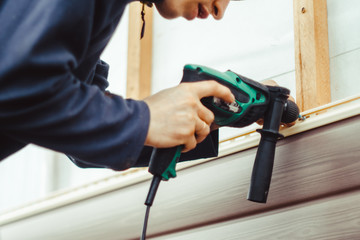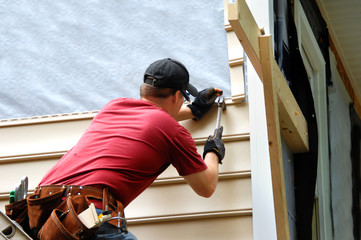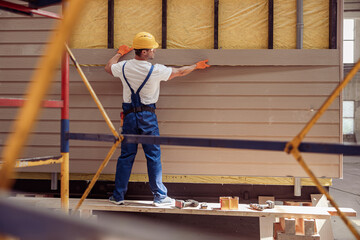Vinyl siding is a common material for home exteriors. It is fairly durable and withstands a number of harsh environmental conditions. Fortunately, it is also very easy to repair minor dents and holes in its surface. In most cases, these repairs can be done without professional help. However, there are some situations where you may need to replace the entire section of vinyl siding.

Besides cleaning the vinyl siding regularly, you should also ensure that the caulking around the doors and windows is in good condition. This will prevent moisture from seeping through the crack and damaging the wood behind it. If you decide to replace your vinyl siding, it is best to call a professional Vinyl Siding Repair Charleston SC. A professional will know exactly how to handle this.
When your vinyl siding is damaged, you can use color-matched caulk to repair it. This caulk comes in various colors and can be painted to match the rest of your home’s exterior.
Whether you have a small hole or large puncture, color-matched vinyl caulk is an easy and inexpensive way to repair the damage. You can buy it at your local siding retailer or online.
Once you have the color-matched caulk, clean the area around the hole with mild dish detergent and water and a soft sponge. Wipe it dry with a rag.
If you have a larger hole, you can use a backer material such as a piece of thin wood or scrap of vinyl siding. Place it in the hole and behind the siding to give the patch a stable surface to adhere to.
When you’re ready to repair your siding, follow these four simple steps: Choose the right color, select the correct size and shape, apply the repair, and finally, paint it to match your siding.
Vinyl siding is a popular choice for home exteriors. It offers the look of real wood, without the maintenance requirements. It comes in several different profiles, including shiplap and dutch lap.
Repairing holes and cracks in these materials is an easy job for a do-it-yourselfer. They use thermosetting resins or epoxies to form a chemical reaction that hardens over damage, resulting in a permanent waterproof seal.
Most kits include a mixture of resin and hardener in equal parts. Then, a fiberglass cloth is added to the mix and applied over the damaged area.
Fiberglass repair kits can be used for a wide range of repairs, including holes, cracks and metal rust-outs. They are a great choice for DIYers because they provide a shop quality repair at a fraction of the cost compared to a part or panel replacement.
One disadvantage to using these types of kits is that they are usually not color-matched to the existing siding. This can be problematic as the color fades over time from UV exposure.
If you have a hole or crack in your vinyl siding that’s too large to fill with caulk, you may be able to fix it by patching. This is especially common for holes caused by tree limbs falling on your house or animal holes that have found their way under the siding.
First, clean the area and let it dry to patch a hole in your siding. Apply a thin coat of color-matched caulk or paintable caulk to the interior perimeter of the hole. Depending on the brand of caulk, you might need to let it dry for a few hours. Then, apply a patch to the damaged area and press it firmly into place. Strap duct tape over the patch to reinforce it.
Another option is to use a full-length piece of siding that is the same color as your existing vinyl. This will give you a seamless repair that doesn’t require cutting the section of siding above the hole.
Paint is a key component of any siding repair project. Using the right type of paint ensures the siding will adhere properly and last longer.
To get the best results, clean the surface thoroughly and fix any damage that may exist before you start painting. This includes cleaning with a power washer and hand scrubbing to remove any stains or dirt that may be on the siding. You’ll also need to use a paint that is formulated specifically for vinyl siding. These paints contain urethane and acrylic resins that help the paint adhere to the vinyl.
Choosing a paint that is the same color or lighter than your current vinyl siding is important. This will prevent excess heat absorption that can cause the siding to buckling or warping. Before you begin the vinyl siding repair process, be sure to check the weather forecast and pick a day that is not too hot or windy. This can ruin your paint job, causing it to peel or flake.

